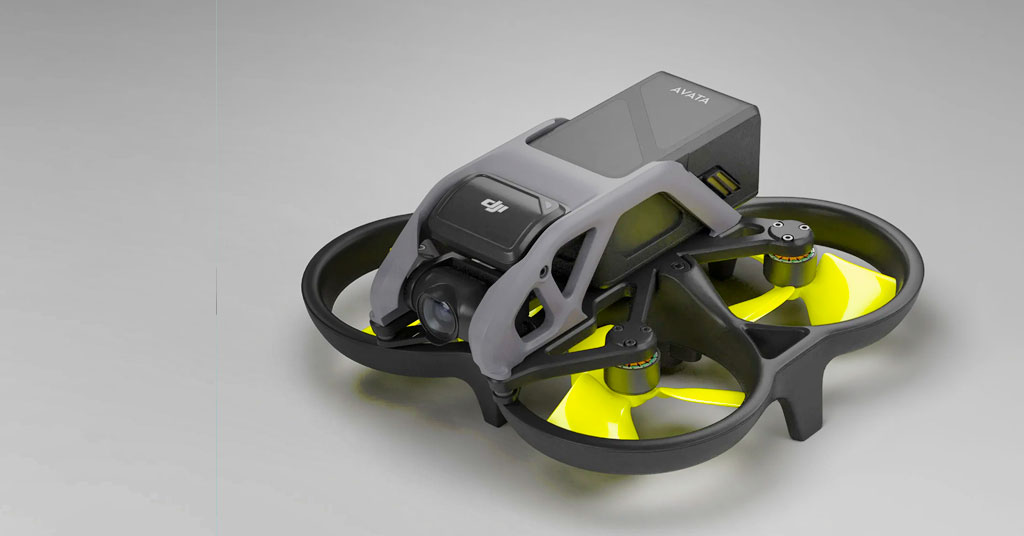DJI’s Avata series has changed the way we fly. With the DJI Avata 3 coming soon, fans are excited to see what new features DJI will bring to the FPV drone world.
The Avata 3 will take what was great about the Avata 2 and make it better. Expect improved camera technology, smoother flight performance, and a more user-friendly experience. Rumors suggest upgrades like a bigger 1-inch CMOS sensor, better stability, and longer flight times. These updates promise a more thrilling and cinematic flying experience.
In this post, we’ll look at the expected features, possible release date, and how the Avata 3 stacks up against the Avata 2 and its competitors. Whether you’re an experienced pilot or just getting started, these updates will help you decide if the Avata 3 is the drone for you.
Today’s Best DJI Avata 2 Amazon Deal

Mason knows photography inside and out. With 15 years of hands-on experience, he’s written about cameras, lenses, and gear of all kinds. He even spent five years as a journalist, diving deep into music and writing sharp, engaging stories. Now, Mason shares his photography knowledge, helping readers find the right gear and perfect their skills. He’s also proud of his unbeatable Wordle streak!
Expected Features of the DJI Avata 3
Enhanced Camera System
- Larger Sensor: Rumors suggest the DJI Avata 3 will use a 1-inch CMOS sensor. This upgrade will help the camera capture clearer images, especially in low-light situations. The new sensor will allow more details to show, even when the light is dim. The bigger sensor is great for professional-grade footage.
- Higher Frame Rates: The Avatar 3 is expected to support 4K video at 120fps. This will let users record smooth, slow-motion footage. Cinematic drone users will love this because it adds a dramatic, polished look to videos. The high frame rate will help make videos feel more fluid and cinematic, giving creators more options to experiment with visual effects.
Improved Flight Performance
- Increased Speed and Range: The DJI Avata 3 might reach speeds up to 140 km/h, much faster than the previous model. This means it can zip through the air quickly, making it great for high-speed flights and racing. The new battery tech should also give the Avata 3 longer flight times, fixing the old problem of needing to land too soon. Pilots can enjoy longer and more exciting flights without worrying about running out of power.
- Enhanced Stability: The Avata 3 should offer better stability in the air. It could have upgraded systems that keep the drone steady, even on windy days or when flying through tricky areas. This stability helps pilots get smoother footage and better control, even in rough conditions.
Advanced Safety Features
- Omnidirectional Obstacle Avoidance: The DJI Avata 3 can detect obstacles from all directions. It uses smart sensors to avoid crashes while flying in tough places, like dense forests or busy streets. This helps the drone move safely through narrow or cluttered spaces, keeping it from hitting things in its path.
- Return-to-Home (RTH) Improvements: The Avata 3 has a better Return-to-Home feature. If you lose sight of the drone or it gets stuck, it will automatically fly back to where it started. Even if visibility is low, it can find its way home using the surrounding environment and sensors to stay clear of obstacles.
Upgraded Goggles and Controller
- Goggles 4 Compatibility: The DJI Avata 3 will work with the upcoming DJI Goggles 4. Expect better display quality and faster response times. These goggles will give you clearer visuals and help you react quicker during flights. It’s all about making your flying experience smoother and more fun.
- New Controller Options: The new controllers for the Avata 3 will be more comfortable and precise. With better ergonomics, they’ll fit your hands perfectly. This means you can control your drone more easily and with better accuracy. The new design will give you a tighter grip, making it easier to fly with confidence.
DJI Avata 3 vs Avata 2: What’s Different?
Camera System
- DJI Avata 3: The Avata 3 is expected to have a much bigger camera sensor, a 1-inch one. This upgrade means the drone can capture better images, especially in low light. With this sensor, you can also shoot video at higher frame rates, which will make your footage smoother and more flexible for editing.
- DJI Avata 2: The Avata 2 has a 1/1.3-inch sensor, which is great, but smaller than the Avata 3’s. It shoots 4K video at 60fps and offers slow-motion video at 2.7K. The camera also features RockSteady stabilization to keep your shots smooth. The color profile and dynamic range are good, but not as strong as the Avata 3’s rumored upgrades.
Flight Performance
- DJI Avata 3: The Avata 3 will likely fly faster and farther than the Avata 2. Though exact numbers are still unclear, you can expect better speed and range for more exciting flights and better coverage in outdoor spaces.
- DJI Avata 2: The Avata 2 has a top speed of 16 meters per second in Sport mode. Its flight time is up to 23 minutes, which is good but may feel short compared to the Avata 3’s rumored improvements. Still, it does support quick charging, which is convenient for longer flights.
Safety Features
- DJI Avata 3: The Avata 3 should have better safety features. This includes improved obstacle avoidance and more reliable Return to Home (RTH) features. These upgrades help you avoid crashes and make sure the drone returns safely if the battery runs low or if you lose connection.
- DJI Avata 2: The Avata 2 already has safety features like visual positioning sensors and RTH. It will return to you automatically if something goes wrong. It’s great for keeping the drone safe, but the Avata 3 will likely take these features even further.
User Experience
- DJI Avata 3: The Avata 3 is rumored to be compatible with the latest Goggles 4 and new controller options. This means the flying experience will feel even more immersive and responsive. It will feel like you’re right there in the cockpit.
- DJI Avata 2: The Avata 2 works with the DJI Goggles 3 and a controller that lets you fly the drone by just moving your hand. The goggles show a crisp, real-time video feed, making it feel like you’re flying the drone yourself. The experience is smooth, but the Avata 3 will likely offer an even better connection and control.
In Summary:
- Camera: The Avata 3 will have a bigger, better sensor, allowing for clearer images and more frame rate options for smoother footage.
- Flight Performance: The Avata 3 should fly faster and go farther than the Avata 2, giving you more room to explore.
- Safety Features: Expect stronger obstacle avoidance and RTH features in the Avata 3, making your flights safer.
- User Experience: The Avata 3 will pair with the newest goggles and controllers, giving you a more immersive, responsive flying experience.
Competitors in the FPV Drone Market
Axisflying 3.5
Overview:
The Axisflying 3.5 is a powerful FPV drone that focuses on performance and flexibility. It gives you the freedom to customize your setup for the best possible flight. You can adjust settings to fit your flying style, making it perfect for more experienced pilots. This drone is built for smooth, cinematic shots and stable flight, whether you’re indoors or outdoors. The frame is tough and designed to last.
Comparison:
While the Axisflying 3.5 excels in manual control, the DJI Avata 3 shines in offering a safe and easy experience. If you’re just starting out or want a safer, more beginner-friendly drone, the Avata 3 might be a better choice. But if you’re looking to get more hands-on with your flight and enjoy controlling every movement, the Axisflying 3.5 is a solid pick.
Fat Shark Dominator HDO3
Overview:
The Fat Shark Dominator HDO3 is a top-tier FPV goggle. It provides a high-resolution, crisp video feed and a wide field of view, helping you feel fully immersed in your flight. These goggles come with OLED displays that show clear, vibrant images. You can adjust the focus to fit your eyes, making them comfortable for long flying sessions. They work well with most drones, and their compact design makes them easy to carry.
Comparison:
The DJI Avata 3 works seamlessly with the new Goggles 4, making it a smooth experience from start to finish. The Goggles 4 are easy to set up and give a clear, comfortable view of what you’re flying. While the Fat Shark HDO3 offers excellent resolution, the Avata 3’s integration with the Goggles 4 makes it easier for users, especially for beginners. You get safety features and a seamless connection with the Avata 3, while the HDO3 focuses more on clarity and field of view.
Release Date and Pricing
DJI hasn’t confirmed a release date for the Avata 3 yet. However, based on how DJI usually releases new drones, many expect the Avata 3 to drop sometime between late 2025 and early 2026. DJI typically follows a 1-2 year gap between major releases, so this timeline lines up with the previous Avata models. The Avata 2 launched in April 2024, which makes late 2025 a likely timeframe for the next release. However, this is just a guess, and DJI may change their plans depending on the market or tech advancements.
The Avata 3 could cost between $1,200 and $1,500, depending on the configuration. Looking at the pricing of past models like the Avata 2, which started at $1,199, it’s clear DJI likes to price their drones around this range. If the Avata 3 has new features or better tech, we might see it closer to the $1,500 mark. The final price will depend on the included accessories and configurations.
What are the rumored camera upgrades for the DJI Avata 3?
Will the DJI Avata 3 be compatible with the DJI Goggles 4?
When will the DJI Avata 3 be released and how much will it cost?
Conclusion
The DJI Avata 3 will offer major upgrades in camera quality, flight performance, and ease of use. The drone’s new features are designed to make it a top choice for FPV fans. With improvements like a larger camera sensor and better flight controls, this drone will give smoother, more immersive flying experiences. It is aimed at both hobbyists and pros who want to push their drone flying skills further.
The DJI Avata 3 is perfect for anyone who loves FPV flying, from beginners to experts. It is designed to be easy to use for newcomers while offering advanced features for experienced pilots. Whether you want to create stunning videos or just fly for fun, this drone is built to handle it.
Keep an eye on MyLensLogic.com for all the latest on the DJI Avata 3. We’ll have news, reviews, and comparisons with other top drones to help you decide if it’s the right one for you. Stay tuned!


